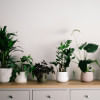5 tips on caring for your indoor plants this winter

Indoor plants can really uplift the outlook of any household. Even during winter when everything is gloomier in general, they can add an air of happiness to our home's decor. However, much like their outdoor counterparts, houseplants too suffer during winter and there are things that we need to keep in mind while ensuring that they have a smooth transition from fall to spring. Here are a few tips that will really help you to keep your indoor plants happy during winter.
Feed them less
This point applies for both water and fertilizer. Since there is less sunlight during winter, our indoor plants won't experience much growth throughout the next few months. They will also require less input from our end. Plants use less water in general during winter so cutting back on watering is a good idea. A good indicator of when to water your plant is its moisture level, which can be checked by poking into the soil. If it is not dry, there is no need to water. As for fertilizers, your plant won't be growing that many leaves during winter and so it won't need the extra supplements.
Move sure that they get light
Sunlight will obviously be at a premium during winter so it is imperative to ensure that your plant is getting enough sunlight. It would be best if you placed them in places where they will receive the maximum amount of sunlight. Examples include near the window or near the balcony and even in your balcony (although that adds the hassle of bringing them back in at night). Alternatively, you can create an artificial environment for your plant by adding specialized light bulbs that help plants cope up with the absence of light.
Keep them in rotation
Continuing along the theme of sunlight and plant placements, if your plants get too much sunlight during winter, it might get overwhelmed and go into shock. Bangladesh winter is different from its western counterparts; the days do get hot from time to time and so it is a good idea to rotate your plants between heat source and draft sources and avoid extremes. This is particularly helpful if you have multiple plants.
Dust them
Sunlight is scarce but you know what's not? Dust. Especially in Bangladesh's context, dust build-up can be a genuine struggle for indoor plants. What dust essentially does is it blocks pores and also harbours harmful pests. While watering can take a back seat during winter, your plants will definitely appreciate a gentle wipe with a damp cloth every now and then to help them absorb light properly and conduct photosynthesis.
Keep pesky pests away
Just like all other creatures, pests too look for warm and dry places during winter and will try to make homes in indoor plants and so it is on us to keep our plants safe from pests. Check for pests regularly by inspecting the leaves and their undersides as well as along the stems and carefully remove any leaves that might be infested to protect the rest of the plant and your other plants as well. The last thing you or your plant would want is a pest infestation.

 For all latest news, follow The Daily Star's Google News channel.
For all latest news, follow The Daily Star's Google News channel. 








Comments